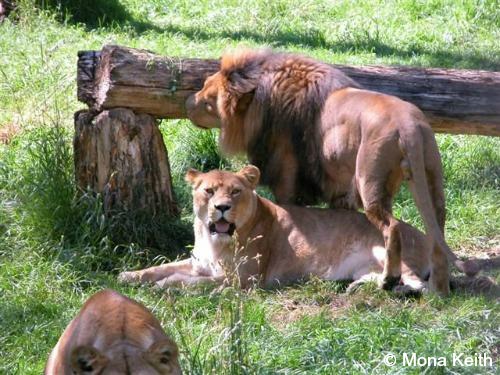- HB Length: 158-250 cm (62-98″)
- Tail Length: 61-100 cm (24-39″)
- Height: 77-109 cm (31-43″)
- Weight: 122-225 kg (269-496 lbs)
- Pop. Trend: Decreasing
To many people, the Lion Panthera leo is the epitome of wild cats. They have long enjoyed a pre-eminent reputation in the symbolism, folklore, and religion of cultures throughout the world.
Lions are the only obviously sexually dimorphic cat, with the male having a noticeable yellowish to dark brown mane of hair on the neck and shoulders. The coat colour of both the male (lion) and the female (lioness) is usually a uniform tawny colour, but can vary from silvery grey to yellowish red and dark ochraceous brown. The face is broad and the muzzle is relatively long with a mostly black nose pad. The iris is yellow to amber in colour, and the pupils are round. The ears are short and rounded with black over most of their backs. The forelimbs are more powerfully built than the hind limbs, and the footpads are large. The tail is relatively long, with a dark tuft of fur at the end. There is often a hard, keratinous growth or spur concealed in the hair tuft. The lioness is noticeably smaller and lighter in weight than the male (20-50%), as well as usually lacking a mane. The Asiatic subspecies, Panthera leo persica, does not look significantly different from the African subspecies, although the males have smaller manes.
Males in the extreme north and south of their African range tend to have fuller manes, which may extend partially along the back and underside of the body. Manes give the appearance of greater size without adding much weight. They are thought to identify sex and adult status to other Lions, as well as give females clues to the health and vigour of the male. They may even assist in individual recognition. Manes also help protect the head and neck areas from injuries while fighting.
Distribution

Once found from southeastern Europe, throughout Africa and the Middle East to northern India, their historic range has been reduced by 80%. They are now scattered through sub-Saharan Africa, with their strongholds being the national parks and wildlife reserves of eastern and southern Africa. There is also a small, isolated population of about 350 individuals in India. See Asiatic Lion.
These cats prefer living on grassy plains, savannah, open woodlands and scrub forest, but can be found in a variety of other habitats from semi-deserts to forests. They have been recorded from sea level to an altitude of 5,000 metres in the mountains of Kenya.
Territories in the Serengeti average 65 km2 in woodlands and 185 km2 in grasslands, with a maximum of 500 km2. Arid areas produce much larger ranges, up to 2800 km2 in the Kalahari.
Ecology
Lions are easily the most social cat species, forming and living in groups called prides. Prides usually consist of four to 12 related females, their offspring, and from one to six males (males may be related to one another also). The size of the pride usually depends on habitat type and prey availability, with the largest prides occurring on the East African plains where there is an abundance of food. In marginal habitats, Lions have been observed to hunt alone. Prides are thought to be formed for a number of reasons, including being easier to protect their territory, more success in hunting co-operatively, and more success in protecting and raising the young.
Lions may hunt by day or night, but are most active between dusk and dawn. They usually hunt using a slow stalk, alternately creeping and freezing, utilizing every available bit of cover before making a final short rush. They regularly take the largest prey species of any cat, including wildebeest, buffalo, zebra, and the young of hippo, elephants and giraffes. They are opportunistic, and will eat a variety of mammals and birds, as well as scavenge carrion. Because they are so big and powerful, they will also take prey that has been killed by other carnivores such as the Cheetah Acinonyx jubatus, and will kill those carnivores to get it.
Reproduction
Lionesses in a pride often come into oestrous and give birth at the same time. The mechanism(s) controlling this phenomenon are not well understood. Females are polyestrous, and heat usually lasts around four days. The gestation period is 100 – 119 days, and one to six, usually two to four, cubs are born in a secluded area. They weigh around 1,200 grams at birth, and their coats are marked with ochre rosette-like spots, mainly on the belly and legs. The coat is quite woolly. Their eyes open by 14 days, and they start to eat meat around four weeks of age. By six months of age, their coats have lost their spots and woolliness. They are weaned at six or seven months, and young males are driven out of the pride between 18 and 24 months of age. As many as 70 – 80% of the cubs die before two years of age, depending on the availability of prey and the ability of the females to provide food. Females are sexually mature at three or four years of age, while males take five to six years. Lifespan is 19 years for females, and 12-16 for males in the wild. They have lived to 30 years in captivity.
Conservation
Lions have been reduced to 20% of their original African range, due to eradication by humans, loss of habitat and loss of prey species which have been replaced by agriculture and livestock. They are persecuted intensely by livestock herders and suffer from widespread official killing as problem animals.
Their habit of scavenging carcasses also makes them highly vulnerable to poisoned bait and snares set to catch animals for the bush meat trade.
Lions are declining rapidly outside of protected areas, and may ultimately only survive in reserves. Small isolated populations also increase the chance of inbreeding and vulnerability to disease. During an outbreak of canine distemper in the Serengeti National Park, over 1,000 lions (40% of the population) died from 1993-1994.
Trophy hunting is legal in 13 African countries, with 600-700 lions – mostly males – being killed every year. Many of these animals are killed in fenced enclosures, a high-priced slaughter which is referred to as canned hunting.
With so many expanding threats to their very existence, careful planning for the Lion’s future must be an immediate priority if these majestic cats are to remain in the African savannahs.
Read about the very small population of Asiatic or Gir Lions in India.
Range Map IUCN Red List 2008
Updated 2013

